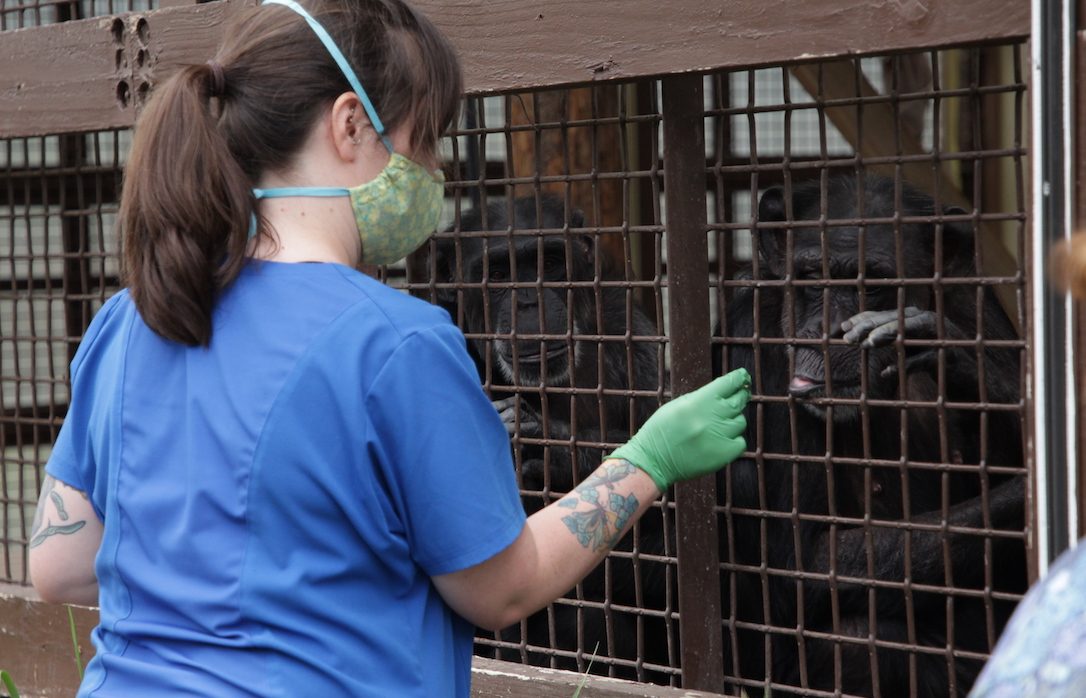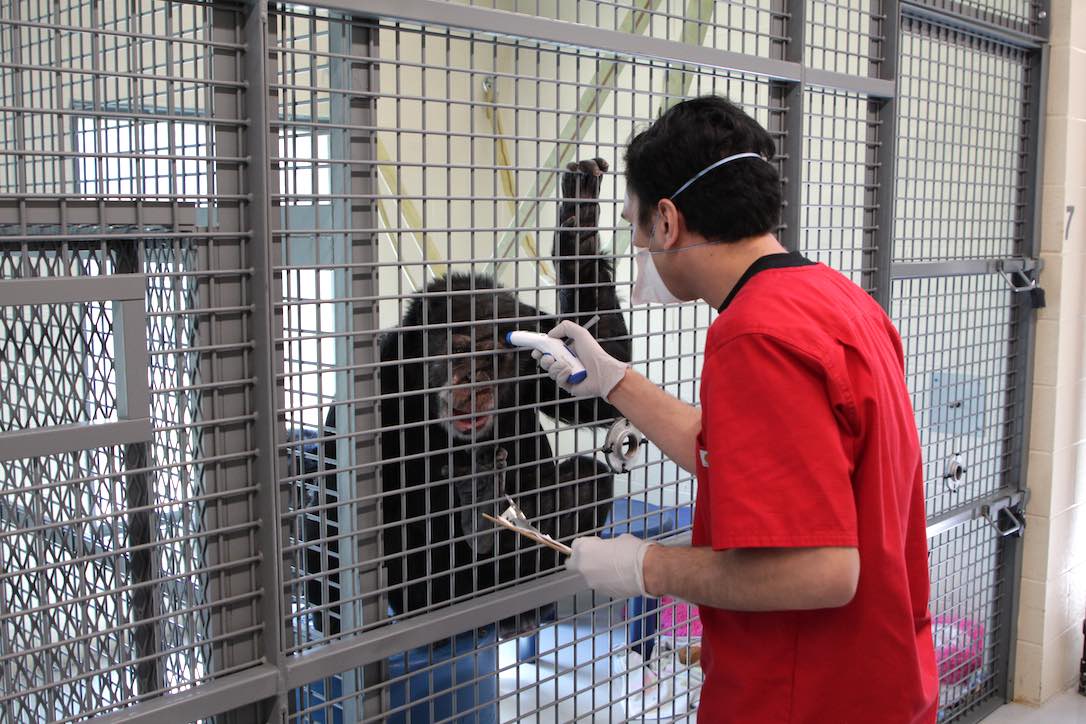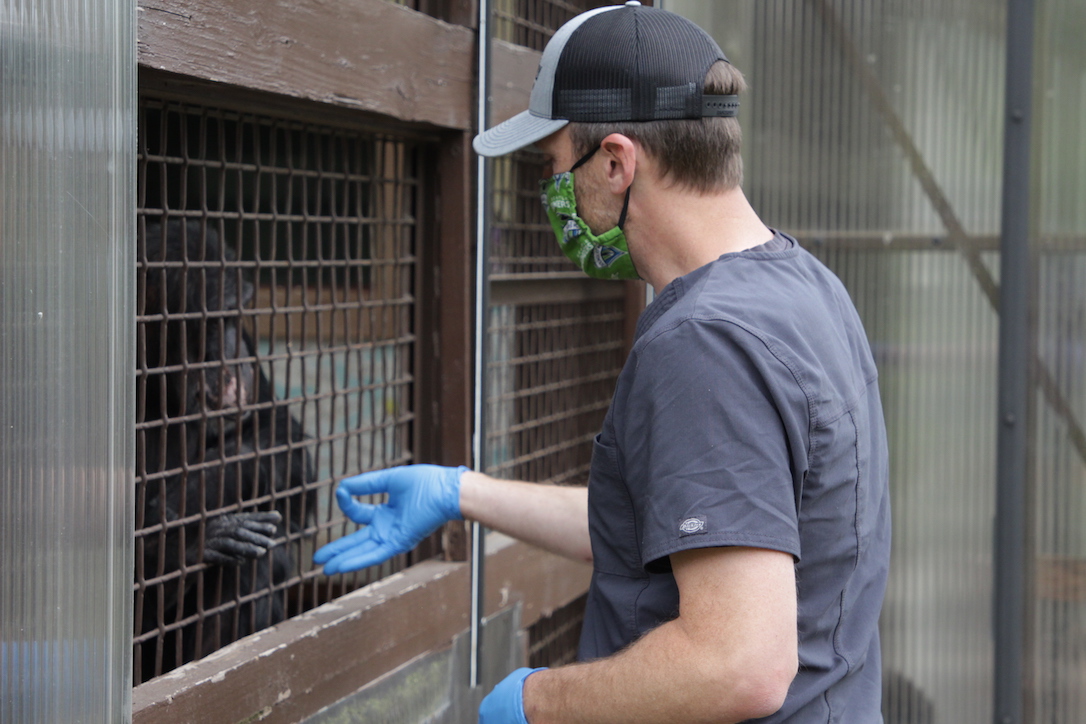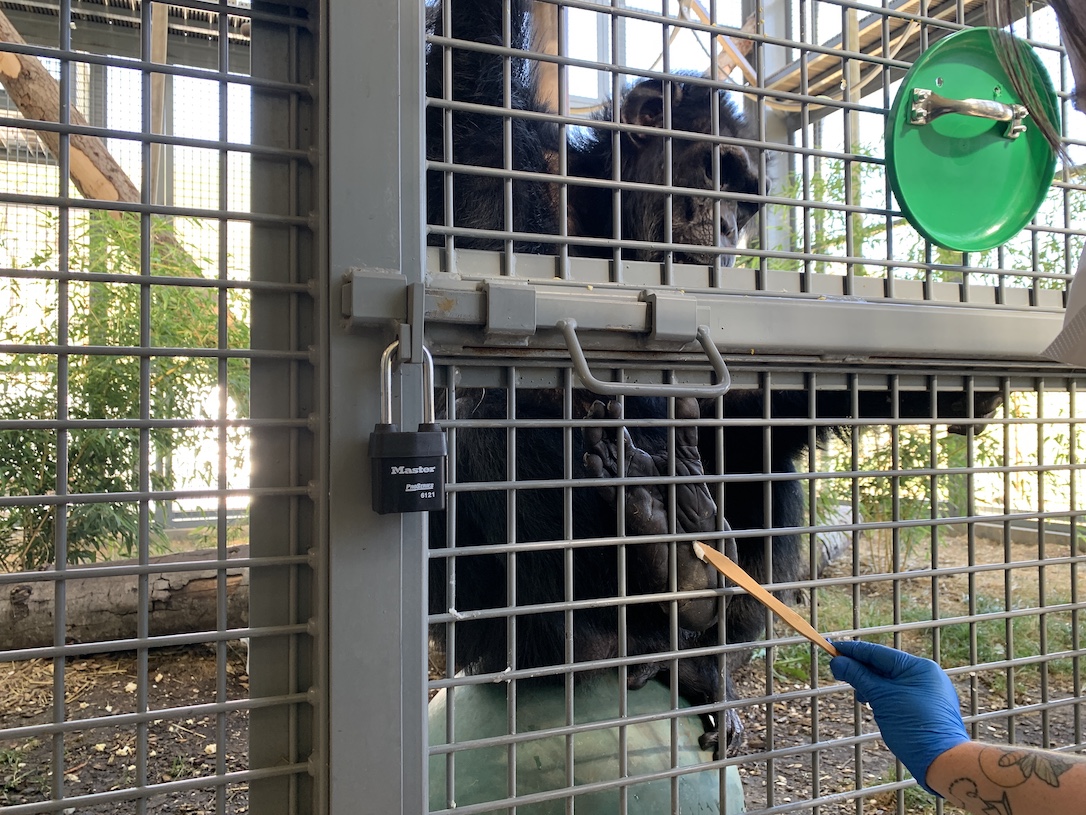When I tell people that I work at a chimpanzee sanctuary, they usually respond with one of the following frequently-asked questions: Do you get to touch the chimps? Do they go outside? Can people visit the sanctuary?
Today’s blog post responds to another common question with a complex answer: Are the chimps trained?
If this question refers to the awful practice of coercing captive primates to perform tasks for our entertainment, then the answer is a plain and emphatic “no.” (“We don’t do that here.”)
When defined more broadly though, behavioral training can be an important practice for improving and maintaining excellent animal welfare. For example, chimpanzees can be taught to voluntarily cooperate in their own veterinary care, greatly reducing the stress and risk associated with medical procedures. Training can also be a powerful tool for improving human-chimpanzee relationships, desensitizing chimps to unfamiliar environmental changes, and providing the chimps with additional cognitive, social and sensory enrichment.
CSNW, like many institutions that care for chimpanzees, has adapted a behavioral training program to improve the lives of the residents. Our past training initiatives have helped us administer medical care and monitor chimpanzee wellness over the years. We are now revamping this framework to utilize a larger staff, accommodate an additional group of chimps, and target loftier goals. Last year, we invited Margaret Whittaker of Creative Animal Behavior Solutions to review training methodology and help us optimize our plans for the future. One key takeaway has been that progress requires a shared understanding of the underlying theory and familiarity with common techniques. We caregivers should understand what training is, value training as an important component of care, and know how to train efficiently and responsibly.
Essentially, training is the process of behavior modification through learning. We often call training between humans “teaching” and training with non-humans “conditioning,” but they’re basically synonymous. Our preferred type of training, operant conditioning, allows the chimps to voluntarily participate and choose which behaviors to present. The chimpanzees are free to come and go at their own leisure, and we never punish them for choosing not to participate. Indeed, certain individuals often decline our invitation because they have better things to do, and that’s okay. In operant conditioning, they’re the operators.
Although the semantics are complicated, the activity of operant conditioning is actually quite simple. First, the trainer uses both a verbal and gestural cue to communicate that a desired behavior will be rewarded in the subsequent window. (You can see an example of J.B. asking Burrito to present his right foot below.) Then, the trainer uses an audible “bridge” to mark the correct behavior and indicate that a treat is on the way. This edible reward is a form of motivation via positive reinforcement. In training jargon, “positive” refers to the addition of a stimulus and “reinforcement” refers to the increase in a desired behavior.
In short, we give rewards when the chimps choose to do desirable behaviors.
You may be wondering why we choose to modify chimpanzee behavior through training. After all, the chimps are wild creatures and we should respect their freedom to choose their own behavior. Even so, captivity is an unfortunate and complicated circumstance, unfairly chosen for them long ago, and purposeful training has the potential to make this environment more comfortable for them. Of course, we caregivers carry the responsibility to only focus our efforts on behaviors that benefit the chimps and use the least intrusive, minimally aversive methods for each.
Some examples of behaviors we train and rehearse are:
Eating cooperatively and/or at stations (allowing subordinate group members to receive food)
Presenting various body parts for injury treatment and monitoring
Receiving injections for vaccinations and sedation/immobilization
Shifting between enclosures to enable cleaning and to facilitate social integrations
Sitting on a bench scale to monitor weight and body condition
In the future, we will also prioritize desensitizing the chimps to uncomfortable but necessary medical procedures, including heart and lung auscultation, radiographs, EKGs and ultrasounds. These approaches usually require that we isolate, immobilize and anesthetize chimpanzees; winning their voluntarily participation is a safer and less stressful alternative for all involved!
I hope to share more content related to behavioral training (including visual demonstrations of our progress) in the near future!









Great conments! Thank you for another thoughtful post!
I’m glad you liked it, Beth!
Great comments! Thank you for another thoughtful post!
Thank you Anthony for teaching me how you use behavioral modification as you tend to keep them healthy, free to engage when they want, & so respectful of their environment. My admiration grows for all who give so much of themselves everyday. Thank you all!
Thank you, Nancy!
Great explanation, thank you, Anthony! I look forward to seeing future demonstrations.
Speaking of training, how’s Willy B doing with his cooperative eating training? Is he better now that he’s in the new group of 9?
It’s always amazing to see animals participating in their own health care through PRT. I see zoos and sanctuaries that have trained their primates (using clicker training) to use KardiaMobile for EKG readings. Will you, or do you, use this on the chimps? (Thinking of Burrito but not sure if EKG is a helpful diagnostic tool for his condition). I think it’s so cool!
Willy is doing well! His behavior is dynamic but he has more patient meals than disruptive ones. We continue to reinforce cooperative behaviors like going to his station marker for each course and allowing others to get their fill.
As for the EKGs, we have a KardiaMobile device and just need to adapt it to our caging and train the behavior. Most chimps already know how to hold their fingers out for training so hopefully we can teach them to sit patiently while holding the device. Being able to get a voluntary EKG would be helpful, for sure!
Kathleen, yes. Clicker training, when done correctly, is incredibly powerful. i trained my Aussie that way and a decade later, not having used it much in the interim, he would come running if I clicked the clicker in another room. Backwards, I know, but I was always amazed by how it stuck after so many years. And of course he got a big treat when he came.
This blog answered the one question I’d been afraid to ask: how do you anesthize the chimps for procedures? I thought surely you aren’t knocking them down like in the labs, but now I know they are trained for injections, so that’s great! Makes me happy.
That’s such a typical Aussie trait! You could call it “backwards” or you could view it as operant conditioning where the clicker was the cue, not the bridge! You’re not wrong, just a rebel. 🙂
I’m glad you asked that question because it made me think about what was missing from my post above. I wrote so much about voluntary procedures, but feel obligated to clarify that not all of the chimps cooperate with these and their responses vary from fearful to nonchalant.
Unlike the laboratories which knocked chimps down for research schedules, we thoroughly consider each chimp’s history and disposition before deciding to bring them into the clinic for only the most necessary procedures. Sadly, chimps who don’t cooperate with injections sometimes have to be “surprised” with the needle or even darted, which only strengthens their fear of suspicious devices. Because of this, we try to minimize the need for anesthetic procedures for these chimps through close observation and other forms of cooperative care
Some chimps, such as Negra, often respond warily to handheld devices and need further desensitization before we can advance any further with cooperative behaviors. Other individuals, including all of the former Waystation chimps and Jamie, are tolerant of needles and seem willing to accept injections when we ask them to. Willy B, for example, voluntarily took multiple injections of sedative before his procedure yesterday.
just wondering…are they trained to go potty in a certain area?
Good question, Susan! No, we do not do any potty training. It’s hypothetically possivle but there doesn’t seem to be a pressing need for it. The chimps are currently free to relieve themselves wherever, but often choose to hang their backsides off a bench or platform and defecate onto the ground underneath. Because of this, feces and urine are often clustered in these latrine spots and can be cleaned up quickly.